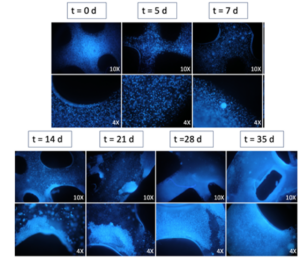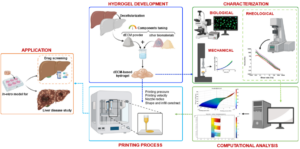Disease Modelling
3D osteosarcoma model
 Osteosarcoma is the most common primary malignant bone tumor affecting children and adolescents. Despite the introduction of several therapeutic options, the treatment and cure of osteosarcoma still remains an open challenge. For this reason, Boron Neutron Capture Therapy (BNCT) has been investigated as an alternative or integrative treatment. BNCT is an experimental binary radiotherapy based on the irradiation with low energy neutron of neoplastic cells previously enriched with atoms of 10-boron (10B). This alternative technique selectively destroys neoplastic cells while sparing normal ones.
Osteosarcoma is the most common primary malignant bone tumor affecting children and adolescents. Despite the introduction of several therapeutic options, the treatment and cure of osteosarcoma still remains an open challenge. For this reason, Boron Neutron Capture Therapy (BNCT) has been investigated as an alternative or integrative treatment. BNCT is an experimental binary radiotherapy based on the irradiation with low energy neutron of neoplastic cells previously enriched with atoms of 10-boron (10B). This alternative technique selectively destroys neoplastic cells while sparing normal ones.
The goal of this work is to create tumor models using 3D bioprinting for BNCT studies. In particular, this study focuses on the optimization of the technical protocol for bioprinting the in vitro osteosarcoma tumor model.
Collaborations
- C. Ferrari, L. Cansolino, E. Delgrosso – Dept. of Clinical Surgical Sciences, University of Pavia
- INFN
- Department of Physics – University of Pavia
- F. Riva – Dept. Public Health, Experimental and Forensic Medicine, Histology and Embryology Unit – University of Pavia
dECM-based bioink for liver 3D bioprinting
 3D bioprinting is an emerging technology in tissue engineering, utilized to model or fabricate tissues and organs by precisely positioning cells into 3D structures using printable biomaterials named hydrogels (bioinks when cells are embedded inside). Developing a bioink, that can offer a biological microenvironment and mechanical properties the most similar as possible to native tissues, is a current challenge on which research in the field of 3D bioprinting and biofabrication is working. Different naturally-derived hydrogels such as alginate, gelatin, collagen, or fibrin, widely used as easy to obtain and produce, are most of the time unable to replicate both of these requirements.
3D bioprinting is an emerging technology in tissue engineering, utilized to model or fabricate tissues and organs by precisely positioning cells into 3D structures using printable biomaterials named hydrogels (bioinks when cells are embedded inside). Developing a bioink, that can offer a biological microenvironment and mechanical properties the most similar as possible to native tissues, is a current challenge on which research in the field of 3D bioprinting and biofabrication is working. Different naturally-derived hydrogels such as alginate, gelatin, collagen, or fibrin, widely used as easy to obtain and produce, are most of the time unable to replicate both of these requirements.
In recent years, a growing interest by the research community is addressed towards decellularized extracellular matrix (dECM)-based bioinks, which are conceived as a new class of biomimetic hydrogels for 3D bioprinting. Decellularization process consists in removing cells from the tissue while preserving ECM native components. For this reason, they contain a unique combination of tissue-specific structural and functional components (e.g. collagens, glycosaminoglycans, and growth factors) that promote cell proliferation and differentiation.
Despite these promising properties, this kind of bioinks shows drawbacks in terms of 3D printability, shape fidelity, and mechanical properties. Aim of this project is the optimization of a new dECM-based hydrogel for extrusion-based bioprinting, and its characterization and validation from a biological, mechanical, and rheological point of view. In particular, this project is focused on liver tissue engineering.
Collaborations
- M. Torre, E. Bari – Dept. Drug Science, University of Pavia
- L. Cobianchi, S. Croce – IRCCS Policlinico San Matteo, Pavia
